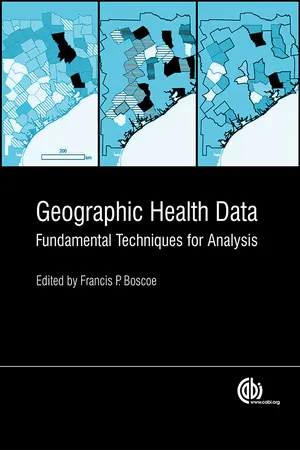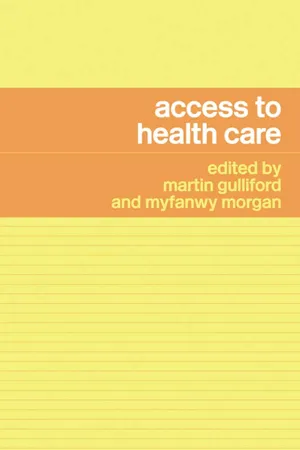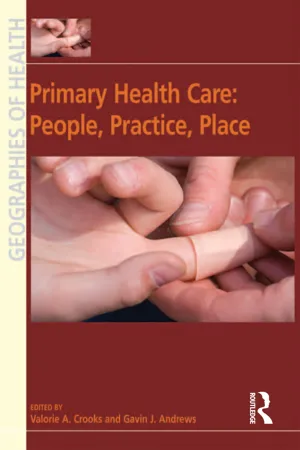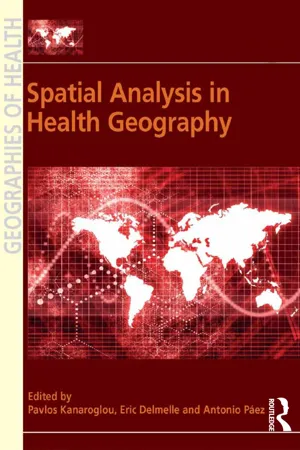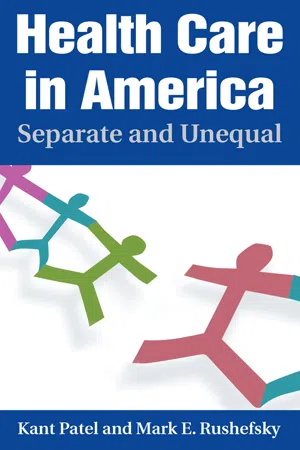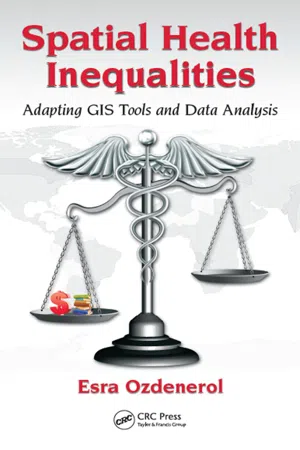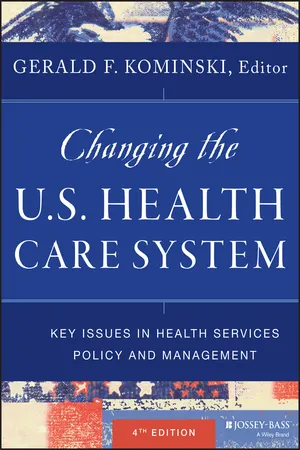Geography
Health Care Access
Health care access refers to the ability of individuals to obtain needed medical services. In the context of geography, it encompasses the spatial distribution of health care facilities and services, as well as the impact of geographic factors on individuals' ability to reach and utilize health care resources. Geographic disparities in health care access can result from factors such as distance, transportation infrastructure, and the availability of health care providers.
Written by Perlego with AI-assistance
Related key terms
11 Key excerpts on "Health Care Access"
- eBook - ePub
Geographic Health Data
Fundamental Techniques for Analysis
- Francis Boscoe, Francis Boscoe(Authors)
- 2013(Publication Date)
- CAB International(Publisher)
9 Geographic Access to Health ServicesKevin A. Henry* and Kaila McDonaldUniversity of Utah, Salt Lake City, Utah, USA9.1 Introduction
Timely access to health care is an important priority among citizens and governments worldwide and is a highly debated political issue owing to the potential social justice and human rights implications of fair access (WHO, 2010). Greater health in a population is most often linked to lower mortality, lower morbidity and fewer disability adjusted life years (DALYs). Policy and research efforts to improve access to health care and eliminate health disparities have mostly focused on access in terms of costs, affordability and health insurance. While these are essential components of access to health care, there are additional components that can influence it too, including the availability of health services in a community (supply), the number of people needing a service (demand) and the travel distance or time between different populations and health service locations. These components are often described in terms of the geographic access to or spatial accessibility of health services.In this chapter, we review the basic concepts related to geographic accessibility to health services, and describe the most common measures for estimating geographic accessibility. We also explain how various measures of geographic accessibility can be applied in a real world setting and provide several worked examples of how to calculate these measures. While you are reading the chapter, we encourage you to begin thinking about health care in your community and the factors that play into your own decisions in utilizing health care services.9.2 Geographic Access to Health Services
Health services include services dealing with the diagnosis and treatment of disease as well as the maintenance and rehabilitation of health. They include services such as cancer screening (e.g. mammography), childhood vaccination, home care services, mental health services, cardiac rehabilitation programmes, hospitalization, dental care, physician care, occupational therapy and child medical services. The term access - eBook - ePub
- Martin Gulliford, Myfanwy Morgan(Authors)
- 2013(Publication Date)
- Routledge(Publisher)
Chapter 2 Geographical Access to Health Care Robin Haynes Introduction Providing equal access to health care wherever people live is not possible in most parts of the world. It is easy to demonstrate that access to health care depends on location in low-income countries, where health services are scarce, and in more developed countries where settlement is spread thinly over vast areas, as in interior parts of North America or Australia. In economically developed and densely populated regions of the Western world, however, distances to high-quality services are comparatively short and the influence of geography on access is not so obvious. This chapter examines the evidence mostly in the context of the United Kingdom, a country which has aimed to achieve geographically-uniform standards of health care for over 50 years. ‘Accessibility’ is the term geographers and planners use to describe the ease or difficulty of reaching services in another place. It has two main components. One is the location of services relative to the population: accessibility is high when people live close to services. The second is personal mobility, the means of reaching the destination. Services are more accessible to people who have cars than to people who do not, and where they can be reached by public transport compared to where they cannot. In an equitable world, accessibility should reflect need. People with the greatest need for a service should be able to reach it more easily than people with lesser needs. The factors that determine geographical accessibility to health services and the consequences of variations in accessibility are summarised in Figure 2.1, which maps the structure of this chapter. In the United Kingdom, the location of health services has been determined by two opposing forces acting on the historical pattern of service availability - eBook - ePub
- Valorie A. Crooks, Gavin J. Andrews(Authors)
- 2016(Publication Date)
- Routledge(Publisher)
Our above discussion of equity references notions of access. Access is certainly a topic of great interest to health geographers and other PHC researchers (see, for example: Feldman 2006; Field and Briggs 2001; Parker and Campbell 1998; Perry and Gesler 2000; Tsoka 2004; Wellstood et al. 2006). Wong et al. (2008) recently conducted focus groups with Canadians regarding PHC priorities, and spatio-temporal accessibility (i.e., timeliness and proximity) was among the six dimensions of care that were identified to be of most concern; this is but one example of the fact that access is also a topic of both interest and concern to health care consumers. As is demonstrated throughout the various chapters of this book, there are many ways of thinking about access in relation to PHC (Bowen 2001). While considering ‘geographic access’ to care (i.e., one’s proximity to a location such as a clinic) is clearly overtly geographic, health geographers’ interest in access extends far beyond this. Access can be further conceived of in relation to culture, economic status and resources, language, and with regard to PHC specifically we can understand that certain care professionals serve as gatekeepers to people’s access to secondary and tertiary care. Barriers experienced by individuals can (in part or whole) make care inaccessible, which can include: (1) availability of services; (2) one’s ability to pay for care; (3) needs-based barriers (e.g., language, awareness, physical accessibility); and (4) inequitable treatment (Bowen 2001). Issues of access as they relate to PHC extend well beyond an individual’s ability to get to and/or use a particular form of care; access is also an important consideration with regard to communities’ abilities to be involved in decision-making (i.e., access to power), nations’ and systems’ abilities to get the money and material goods needed in order to initiate and continue care delivery (i.e., access to resources), and even services’ abilities to attract and retain qualified personnel in order to meet health human resources needs (i.e., access to workers). - eBook - ePub
- Pavlos Kanaroglou, Eric Delmelle(Authors)
- 2016(Publication Date)
- Routledge(Publisher)
Aday and Andersen (1974) discuss the way in which socio-organizational and geographic components of access can be reasoned as separable, or at least distinguishable. In a sense, accessibility is more than simply the presence of a healthcare service; it is also a function of the geographic separation between someone in need of care and someone able to provide care. Attempts to isolate the geographic components of access are key in furthering research on spatial inequalities in health. The idea of distributional fairness, also commonly encountered as spatial equity (Talen and Anselin, 1998; Truelove, 1992), is a relatively longstanding attempt to do this, and derives its specification from the wider definition of healthcare equity. The World Health Organization (WHO; Whitehead, 1992) is instructive in its definition of healthcare equity as: equal access to available care for equal need; equal utilization for equal need; and, equal quality of care for all (p. 432).While a geographic approach on its own could be viewed as reductive, a considered approach to space has produced startling work on the past unevenness of care in urban contexts (Knox, 1978; Knox and Pacione, 1980) as well as helping to define one of the most enduring representations of inequality in health: the inverse care law. Hart (1971) defines this law as the availability of health services varying inversely with patient need, a feature of the health landscape only emphasized in past years by media scrutiny on the existence of “postcode lotteries.” That the quality of care you receive might be a function of where you live is a distinctly spatial characteristic of access to, and use of, healthcare. The Marmot Review (2010) has most recently recast this in terms of a “social gradient” in health in the UK.The field of theories and models of access and use of healthcare services is large, and covers a number of sub-disciplines. My approach is health-geographic, and aims to focus in on the inequalities brought about by the spatial arrangement of health services and their patients. This spatial focus is an important subset of the behavioral model of health utilization, and picks up particularly on the accessibility and availability components of Penchansky and Thomas’s (1981) dimensions. It is aligned with established geographic ideas about injustice (Dorling, 2010), and crucially, it is an examination of the question of: “Who gets what, where, and how?” (Smith, 1977). - eBook - ePub
Health Care in America
Separate and Unequal
- Kant Patel, Mark E Rushefsky(Authors)
- 2015(Publication Date)
- Routledge(Publisher)
———— 8 ———— Geography and Health Care It is a maxim of business that success is based on “location, location, location.” If you just have your business in a place where you can get customers, then your business is more likely to prosper. Place, or geography, is the subject of this chapter. We have examined disparities from a number of different angles: race, ethnicity, gender, age, and income. And all of these factors come into play in this chapter as well. But place adds another dimension. Does access to health care, the health of residents, and the quality of care differ based on where one happens to live? The answer, in short, is yes. There are, documented in the health care literature, variations in practices by geographic boundaries (see, for example, Baicker, Chandra, and Skinner 2005; Baicker et al. 2004; Wennberg 2004). This affects all the different groups discussed in previous chapters. The interaction of place with these other factors complicates understanding health care disparities. The chapter proceeds as follows. In this introduction we will set forth the boundaries of geographic health care inequalities by exploring different geographical areas. We then look at health disparities of outcome, access, and quality of care based on geography. That is followed by a discussion of reasons for the disparities and attempts to reduce geographically based disparities. In this chapter we shall also explore the various other factors that create disparities. A Health Care Geography The National Health Care Disparities Report (Agency for Healthcare Research and Quality 2006, 182) distinguishes four geographical areas. The largest metropolitan areas are those with a million or more residents. Smaller metropolitan areas are those with less than a million residents. “Metropolitan urban areas” have 10,000 to 50,000 residents - eBook - ePub
Health and Inequality
Geographical Perspectives
- Sarah E Curtis(Author)
- 2003(Publication Date)
- SAGE Publications Ltd(Publisher)
However, health system performance is not always related straightforwardly to health service expenditure. For example, data shown below suggest that the USA and Switzerland, spending over 1600 international dollars per annum on health care, had indices of responsiveness and fairness which were no better than the UK, Spain, or even Jordan, which were spending much less. India appeared to achieve relatively high levels of performance in terms of fairness, although expenditure was less than 100th of that in the western countries shown here. This illustrates the importance of considering various aspects of service performance when assessing international geographies of health care provision and consumption. It is not sufficient to consider only levels of expenditure.PHYSICAL INFRASTRUCTURE AND SPATIAL ACCESS
Castells (1977) also pointed out that the city in the capitalist system provides a physical infrastructure for reproduction of labour power in the form of facilities for consumption of essential services at the local level. The physical elements of service infrastructure are relatively fixed in space (for example, school buildings, hospitals, railways) and they are often most accessible to populations living closest to them.Health geography has devoted considerable attention to the spatial distribution of health facilities as a factor influencing heath care use. This has been researched over a long period. For example, Hunter and Shannon (1985) have considered the 19th century work of Jarvis, who identified a distance decay effect in the use of hospitals, showing that rates of use of hospital facilities for geographically defined populations tend to decline as distance from the hospital increases. The importance of distance as a variable in access to health care has continued to be of concern to geographers up to the present day. Joseph and Phillips (1984) and Thouez (1987) discussed research in this field in the 1980s, and Gatrell (2002: 158–61) has reviewed several more recent examples of studies of use of secondary and tertiary health care services that demonstrate distance decay effects.Spatial organization of health care can be considered in the light of broader geographical perspectives on the catchment areas of service facilities. These have included central place theory, which invokes the idea of a hierarchy of service centres, such that lower order centres offer services to a local catchment, while higher order centres provide a larger range of services over a wider area (Carter, 1981). The concept of the ‘gravity model’ extends these ideas about the geographical range of catchments. This model specifies a distance decay effect in use of a service facility. It estimates utilization as inversely proportional to the squared value of distance between the consumer and the facility. The distance travelled (or time taken to travel) to hospitals has been used in the estimation of likely use of hospital facilities by different communities and to assess how the reorganization of hospital services changes access to services. For example, Congdon (1996c; 2000) used gravity modelling to assess the regional impact of hospital closures in north-east London on access to accident and emergency services. Lowe (1996) examined the impact on access to hospitals that might result from the introduction of universal coverage in a hospital system in the USA and also the potential impact from hospital closures. In this study, the changes were expected to be most significant for poor neighbourhoods. - eBook - ePub
Geographies of Care
Space, Place and the Voluntary Sector
- Christine Milligan(Author)
- 2017(Publication Date)
- Routledge(Publisher)
2 Geographical Perspectives on Health IntroductionAs care has moved from institutional to community-based sites of delivery, concern has focused not only on the relocation of the locus of care, but also on the new sets of actors and agencies involved with its planning and provision. Attention is drawn to the ways in which decisions are made and how the social processes of care reform operate in particular places. The relationship between healthcare and the means through which social, cultural, political and economic influences alter the experience of health and illness across space and within places has been of particular interest to medical geographers in recent years.The study upon which this book is based builds on work that has emerged from several strands of contemporary geographical thinking. Such work maintains that for a clearer understanding of how and why specific patterns of health and healthcare emerge in particular places at particular times, there is a need to extend the focus of medical geography to incorporate a wider view of health and healthcare. These broadly embody the recognition of a need to move away from bio-medical approaches to the geographical analysis of health issues, to incorporate social models of health and healthcare. Such approaches also highlight the potential benefit of integrating multi-disciplinary perspectives to geographical analyses, and the need to understand how wider contextual factors impact on experiences of health and healthcare. To understand why these issues are of importance here, this chapter gives a brief history of the development of medical geographical thinking, identifying some of the main elements that have informed the study. In doing so, I discuss some of the main ‘traditional’ theoretical and epistemological positions through which aspects of health and illness have been examined within medical geography, and how development in thought across the discipline as a whole has become manifest in terms of “contemporary’ perspectives in geographies of health and healthcare. - eBook - ePub
Spatial Health Inequalities
Adapting GIS Tools and Data Analysis
- Esra Ozdenerol(Author)
- 2016(Publication Date)
- CRC Press(Publisher)
6GIS’s Applications in Health-Care AccessThe amount and type of health-care services populations receive depend greatly on where they live, the capacity of the health-care system in their area, and the methods practiced by local providers. Different populations need particular services, and they need to be located within reasonable distances of the services they need. Knowing the demographics of an area, where health problems are prevalent, the demand for any particular service, and standards of care may help health-care organizations to decide how to allocate finite health-care resources and where to build new facilities and design population-based interventions.Measuring the spatial accessibility (i.e., based on travel times between residents and physicians or areas within a certain travel time of each other), aggregating various sociodemographic variables to administrative boundaries, calculating geographic centroids and population-weighted centroids, geocoding physician locations, simple overlays, clustering of utilization are fundamental geographic information systems (GIS) functions applied in health-care resource planning. Computing accessibility measures in GIS using network distances and more precise aggregation methods is no longer a daunting task. The time required for the computation of numerous network distances or aggregating voluminous data to high-level census boundaries is no longer a limitation. Most practicing physicians and policy makers have access to Google Maps, in-house GIS, and/or online GIS tools (e.g., ArcGIS.com - eBook - ePub
Healthcare System Access
Measurement, Inference, and Intervention
- Nicoleta Serban(Author)
- 2019(Publication Date)
- Wiley(Publisher)
Thirdly, not all factors may be observed on the same geographic granularity as the access measures; for example, if observed at higher geographic resolution (e.g. census tract), then the predicting factors need to be aggregated into the lower geographic resolution (e.g. county) with consideration of the challenges of combining incompatible spatial data, particularly the modifiable areal unit problem (Gotway and Young 2002). Case Study: Access to Pediatric Primary Care Healthcare systems have the best health outcomes when based in primary and preventive healthcare. The first case study in this chapter focuses on evaluating disparities in healthcare access to primary care with an emphasis on disparities between children with public insurance (Medicaid/CHIP) and those with other forms of health insurance. Specifically, the aim of this study is to assess systematic disparities across two substantive dimensions of access for pediatric primary care, accessibility, and availability, together referred to as spatial access, defined in earlier chapters. The implementation of the optimization model for estimating spatial access to pediatric primary care is introduced and described to a great extent in a collaborative paper (Gentili et al. 2018). Low geographic granularity estimates are needed to evaluate geographic disparities and capture the nuances of healthcare access, important for targeting interventions (Gentili et al. 2015). Thus, we estimated access at the census tract level, where census tracts are delineated to be proxies of communities - eBook - ePub
Geographies of Health, Disease and Well-being
Recent Advances in Theory and Method
- Mei-Po Kwan(Author)
- 2016(Publication Date)
- Routledge(Publisher)
The study observed distinctive geographic patterns and racial differences in the utilization of cancer screening services (e.g., Hispanics in six states are significantly more likely to utilize mammography than whites). Shi et al. (Chapter 26) assess demand for cancer screening facilities using a two-step floating catchment area method that takes into account both travel time and facility capacity. The results show distinctive geographic patterns of demand for cancer screening facilities: spatially continuous but relatively low in eastern regions but sporadic and tends to be high in the west. Using patient registration data, Lewis and Longley (Chapter 27) examine access to primary health care in the London borough of Southwark. The study observed that different ethnic groups have different behavioral patterns in accessing general practitioner-run health centers. Four chapters explore pertinent issue of health and well-being in various contexts through feminist, therapeutic landscape, and nature-society perspectives. They emphasize the importance of local-level social and cultural dynamics that shape health behaviors and outcomes. Based on two case studies, Thien and Del Casino (Chapter 28) demonstrate how various sociospatial practices of masculinity affect men’s health and their affective relationships with support systems for health. The article concludes that “men’s health is not only about the management of their responsibilities as political citizens but as biological citizens with all the attendant emotional geographies.” Pope’s chapter (Chapter 29) addresses the recent history of HIV and HIV policy in Cuba and Belize through a therapeutic imaginaries framework. Through these two case studies, it shows that countries in the same region can develop different care policies that lead to different biomedical and sociocultural outcomes - eBook - ePub
Changing the U.S. Health Care System
Key Issues in Health Services Policy and Management
- Gerald F. Kominski(Author)
- 2013(Publication Date)
- Jossey-Bass(Publisher)
access as actual use of personal health services and everything that facilitates or impedes their use. It is the link between health services systems and the populations they serve. Access means not only visiting a medical care provider but also getting to the right services at the right time to promote improved health outcomes. Conceptualizing and measuring access is the key to understanding and making health policy. Monitoring and evaluating access allows us to (1) predict use of health services, (2) promote social justice, and (3) improve effectiveness and efficiency of health service delivery.This chapter presents a conceptual framework for understanding the multiple dimensions of access to medical care. The sixth revision of the behavioral model in this edition is expanded to include (1) genetic susceptibility as an individual predisposing factor and (2) quality of life as an outcome factor. Consequently, the description of these factors is somewhat more detailed than that of the other factors in the model. The various types of access are considered and related to their policy purposes. Examples of access indicators are provided, including potential, realized, equitable, inequitable, effective, and efficient access indicators. Trend data are used to track changes that have occurred over time in these access indicators. The chapter addresses these questions: Are access, indicators of the U.S. health care system improving or declining? For whom? According to what indicators? How might access be improved?Understanding Access to Health Care
This section presents a conceptual framework based on a behavioral model of health services use that emphasizes contextual as well as individual determinants of access to medical care. Dimensions of access are defined according to components of the framework, and we examine how access might be improved for each dimension.Conceptual Framework
Figure 2.1 stresses that improving access to care is best accomplished by focusing on contextual as well as individual determinants (Andersen, 1995, 2008; Andersen & Davidson, 2007). By contextual
Index pages curate the most relevant extracts from our library of academic textbooks. They’ve been created using an in-house natural language model (NLM), each adding context and meaning to key research topics.
